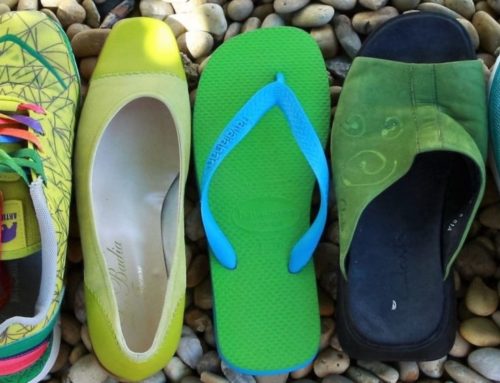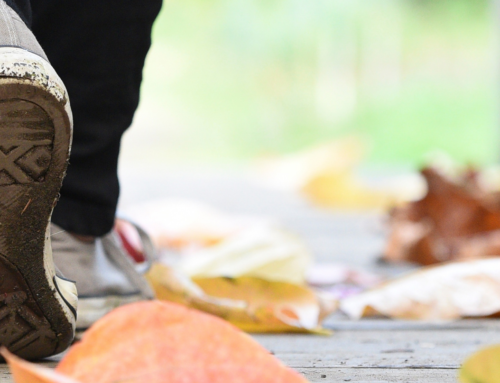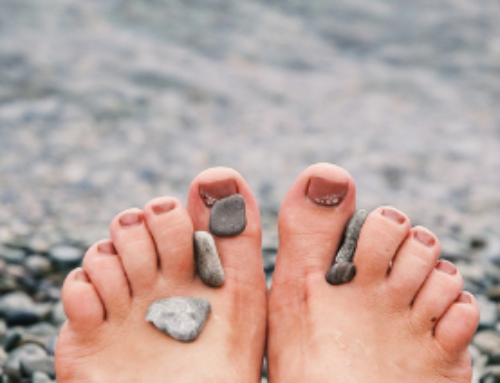During a foot, hand, or ear reflexology session it is common, and expected, to experience what we reflexologists call areas of sensitivity. An area of sensitivity might feel tight, crunchy or granular, sharp, or dull. When I use a specific finger and thumb technique over the area it might be sore but feel really good to have the area worked on, or it could feel sharp and make you want to pull away from the pressure technique. Neither responses are bad or good, they just give us feedback that there's something happening in this area or the corresponding region of the body. My colleagues and mentors, Barbara and Kevin Kunz, coined the term stress cue. When we come across an area of sensitivity it's a clue that there's some kind of stress going on, either in the soft tissue of the area being directly worked on, or in the corresponding region of the body.
The liver reflex
The right lobe of the liver reflex point in Foot Reflexology is located on the right foot. It extends from the 5th metatarsophalangeal joint to the 1st metatarsophalangeal joint, under the ball of the foot. The point goes all the way down to the tuberosity of the 5th metatarsal on the lateral edge of the plantar surface. The left lobe extends to the left foot from the 1st metatarsophalangeal joint nearly to the 3rd metatarsophalangeal joint. Using my rudimentary design skills (aka Microsoft PowerPoint), here's my approximation of the liver reflex point on the plantar (bottom) surface of the feet: As you can see it takes up a goodly portion of the middle of the right foot! It is generally thumb-walked with passes made both horizontally and vertically moving lateral to medial and back and proximal to distal and back, but I may also use finger-walking and other reflexology-specific techniques over this reflex area.
As you can see it takes up a goodly portion of the middle of the right foot! It is generally thumb-walked with passes made both horizontally and vertically moving lateral to medial and back and proximal to distal and back, but I may also use finger-walking and other reflexology-specific techniques over this reflex area.
Why does my liver reflex hurt?
We have two possibilities for why a reflex area may be sensitive when worked on: 1.) the area directly being worked on is under stress, 2.) the corresponding region of the body is under stress.
It's a foot thing

Let's first explore why these regions of the feet could be bothering you. Lifestyle plays a major role in the tone and proprioception of the feet. Those of us who spend most of our day seated will experience a shortening in the muscle and tendon groups in the backs of the legs running from the buttocks to the heels. Have you tried to bend over to touch your toes after an 8-hour work day at the desk and barely make it to your shins? That's going to cause a subtle increasing tug on the arches of the feet, as pictured right. The anterior transverse arch runs right along the top part of the liver reflex area on both feet. When one arch is experiencing dysfunction all three arches are affected.
" data-medium-file="https://i0.wp.com/www.thebarefootdragonfly.com/wp-content/uploads/2018/02/Ankle_Pronation_Position.png?fit=300%2C219&ssl=1" data-large-file="https://i0.wp.com/www.thebarefootdragonfly.com/wp-content/uploads/2018/02/Ankle_Pronation_Position.png?fit=424%2C310&ssl=1" class="size-full wp-image-4208" src="https://www.thebarefootdragonfly.com/wp-content/uploads/2018/02/Ankle_Pronation_Position.png" alt="" width="424" height="310" /> Ankle Pronation – Supination by Ducky 2315 Creative Commons
Another possible explanation for stress to show up in this region of the foot comes from structural alignment affecting the ankles. This could be one hip sitting higher or tilted more forward than the other, an old knee injury, being overweight, or from improper footwear. The image to the right depicts:
- Pronation – where the alignment shifts the weight to the medial aspect of the foot, that's the big toe side, causing one or both knees to move towards each other.
- Neutral – where the weight is evenly distributed with the midline of the lower extremity.
- Supination – where the alignment shifts the weight to the lateral aspect of the foot, that's the little toe side, causing one or both knees to rotate outward in a bow-legged way.
When the biomechanics of movement of the leg and foot are changed undue stress forms where muscles, tendons, ligaments, and joints are under- or over-performing.
As a reflexologist I do a visual assessment of your gait and the way you move your body from the moment you walk in the door. I may be asking about your day, commenting on the weather, and checking in about your wellness but I'm also noticing that your right shoulder is a little closer to your ear lobe than your left, or that your left foot is pivoted outward causing extra strain on the foot, knee, hip, and shoulder. I won't be surprised to find some stress cues going on in corresponding reflex areas and I might even mention it out loud that I've spent extra time on the shoulder area reflexes because it looked a bit tight walking in.
It's a liver thing
Now, it could still be that the area of sensitivity is pointing to stress in the liver so let's explore what that looks like. In Traditional Chinese Medicine, or TCM for short, the liver regulates flow of qi, or energy, and blood through the body. When external and internal stressors affect the energy of the liver we see patterns like the following:
- difficulty relaxing and "going with the flow"
- mood is often nervous with anger and frustration close to the surface
- muscle tone is tense and prone to spasms
What does the liver actually do? Most of us know it is implicated in hang overs but what is it's job? Well, to start the liver and gall bladder work together to produce bile which helps us break down foods in the digestive tract. And you're correct, it plays an important role in metabolism and detoxification of foods, drugs, hormones, alcohol, supplements, environmental pollutants, and so forth. The liver also acts as a warehouse for glycogen (our fuel source), vitamins, iron, and other micronutrients. It works in conjunction with the pancreas to ensure that our organs and muscles have enough fuel to function optimally.
Why your liver reflex hurts
 In short, your liver reflex could be sensitive or even painful if you:
In short, your liver reflex could be sensitive or even painful if you:
- are experiencing a period of stress that is making your feel nervous and irritable
- are experiencing tension patterns that are affecting the biomechanics of the lower extremities
- have prediabetes, or are diabetic
- consume alcohol, use recreational drugs, or have liver damage from a history of either (such as cirrhosis or metabolic dysregulation)
- are on an over the counter or prescription medication
- are experiencing dysregulation in either the digestive system or the endocrine system
- have overindulged with sugar or fatty foods in the last 24 hours
- or stepped on a Lego(R) last night putting the kids to bed and forgot to mention you had soft tissue trauma there!
Now you'll know what's potentially going on in that reflex area next time it is sensitive in a foot reflexology session! Please feel welcome to make use of the comments section to share experiences or feedback. Need a reflexology tune-up? Head over to the online scheduler and book today!









I am experiencing liver issues and came across your site researching reflex points for the liver. Thank you so much for your informative and amazing site! I am a Nationally Certified Massage therapist who became certified in 1994 in San Antonio. I now live in Santa Cruz, CA but still have family in TX. I will be coming to see you next time I am there!
Glad you found the post useful, Cheryl! The Reflexology Association of California has an online directory you may wish to check out for a reflexologist near you: https://www.reflexology-ca.org/find-a-reflexologist.html
I had my first reflexology treatment yesterday. My therapist mentioned that she noticed congestion in my liver. Can reflexology help with the congestion or are there other things I should do to support my liver?
Sounds like a consultation is in order. Let me know if you need assistance scheduling an appointment.